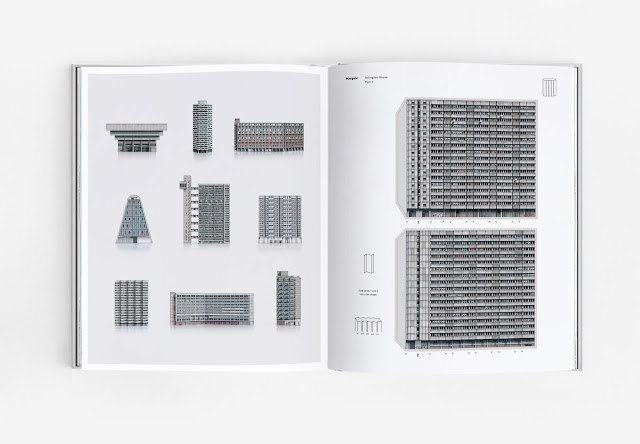
Spied in a trendy bookstore in Broadway Market, Hackney, a few weeks ago
Strange to think that this particular retro-fetish is still puttering on - 15 years after Militant Modernism, almost a quarter century since Boring Postcards
One almost wants to start a counter-current and whisper that "actually, living in one of these buildings wasn't a picnic" - certainly once the initial honeymoon bloom wore off... (Speaking as someone who spent about 9 months in a low-rise block on Brixton Hill back in '87-88.)
High-rise tower blocks, prefab panel housing estates, streets in the sky, new towns; some of the concrete constructions that once shaped the cityscapes of post-war Britain have stood the test of time, while others are long gone.
Brutal Britain by Zupagrafika celebrates the brutalist architecture of the British Isles, inviting readers to explore the modern past of Great Britain and rebuild some of its most intriguing post-war edifices, from the iconic slabs of Sheffield`s Park Hill and London's Trellick Tower, to the demolished Birmingham Central Library.
Opening with a foreword by architectural historian Barnabas Calder, the book includes short chapters with full-page colour illustrations and informative texts on each building, along with 9 press-out paper models featuring all kinds of details originally present on the facades. All models are die-cut and pre-folded with simple assembly instructions attached: all you need is glue.
Arlington House. Margate
Birmingham Central Library. Birmingham
Cables Wynd House (Aka Banana Flats). Edinburgh
Cotton Gardens Estate. London
Hutchesontown C. Glasgow
No. 1 Croydon. Croydon
Park Hill. Sheffield
The Toast Rack. Manchester
Trellick Tower. London
"Build your miniature postwar paradise from the models in this book. Very sadly, shortsighted building managements and weak heritage protection for postwar architecture mean there is a real chance that, if you use decent glue, your models could survive longer than some of the original buildings did.”
– Dr Barnabas Calder
Release rationale for London Estates: Modernist Council Housing 1946-1981 (Fuel, March 2024)
The most comprehensive photographic document of council housing schemes in the capital, with incredible images from every London borough and the City, featuring 275 estates built between 1946 and 1981.
London Estates documents these important buildings in all their diversity, championing the neglected alongside the distinguished, celebrating their vital contribution to the social and architectural fabric of the capital.
Featuring designs from a broad range of architects including Denys Lasdun (Keeling House, Trevelyan House); Chamberlin, Powell & Bon (Golden Lane Estate), Ernő Goldfinger (Balfron Tower, Trellick Tower); Basil Spence (Stock Orchard Estate, Tustin Estate), and Kate Macintosh (Dawson’s Heights).
London Estates: Modernist Council Housing 1946-1981 reviewed by Municipal Dreams
"You'll be left in ruins for your wrongdoings.... Brutal and British!"


















6 comments:
Flammable cladding not included, I presume.
The problem with Brutalism is that always looks much better on a model scale. It should have remained a purely conceptual form of architecture.
Part of the problem with these buildings is that humans live in them (and their pets).
Then there's the ravages of weather and Nature.
This bit from the 'build your own brutalist building' book is amusing:
"Build your miniature postwar paradise from the models in this book. Very sadly, shortsighted building managements and weak heritage protection for postwar architecture mean there is a real chance that, if you use decent glue, your models could survive longer than some of the original buildings did.” – Dr Barnabas Calder
I lived in one of the flats in the Alexandra Estate in Swiss Cottage for 6 years at the turn of the century and it was a brilliant flat, as sturdy as they come, and the housing co-op made regular repairs etc. Brilliant location and cheap. Just what I needed in my mid-20s.
But living amongst all that endless concrete, especially on grey English days, was not good for the soul. It could get you down on a Sunday afternoon.
The place I lived was fine inside - well, apart from a curious 1970s feature, which was underfloor central heating, Roman villa style. This did make the place cosy in winter but the heat released all the odors impregnated in the fitted carpets (another very 1970s feature).
Approaching the building from outside, its aspect was fairly grim. And the stairwells were the cliche - graffitied, murky, sometimes piss stained, the occasional dog turd.
Is this some kind of Scarfolk style satirical book or just the usual middle class poverty fetishism
It’s neither: the London Estates one makes everything look clean and precise (more so than the buildings look in real life), in order to emphasise the clean lines of the architecture.
Kind of the opposite of poverty fetishism. What’s wrong with liking modern building?.
Post a Comment